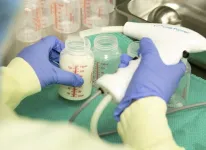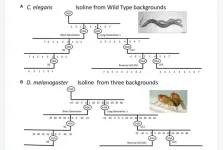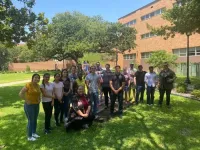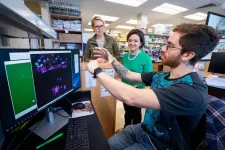(Press-News.org) A team of University of Toronto Engineering researchers, led by Professor Timothy Chan, is leveraging machine learning to optimize the macronutrient content of pooled human donor milk recipes.
The researchers introduce their data-driven optimization model in a new paper published in Manufacturing and Systems Operations Management.
Chan and his team worked with Mount Sinai Hospital’s Rogers Hixon Ontario Human Milk Bank — which provides donor milk to preterm and sick babies who are hospitalized across Ontario — as well as Dr. Debbie O’Connor, a professor at the Temerty Faculty of Medicine.
“For a variety of reasons, many hospitalized infants do not have a full supply of mother’s milk. In this instance human donor milk can be lifesaving particularly as it helps to protect preterm infants from necrotizing enterocolitis, a life-threatening bowel disease,” says Dr. Sharon Unger, a neonatologist and the medical director of the Rogers Hixon Ontario Human Milk Bank.
“The new program developed by Dr. Chan helps to ensure that each batch of human donor milk meets the protein and calorie needs of preterm infants.”
Currently, many milk banks, including Mount Sinai’s, rely on individual decision making when pooling donor milk. This presents a significant challenge in producing a consistent donor milk product that contains sufficient macronutrients for premature and sick babies in neonatal intensive care units.
“It takes a lot of time to create these recipes without a defined method,” says Chan.
“While there are studies that show that milk that comes from donors who are early in their postpartum period tends to be more protein rich, our approach provides a good prediction of the actual macronutrient content that will allow milk bank employees to make better pooling decisions.”
Given that milk banks are often non-profit entities operating on lean budgets, a low-cost alternative to obtaining a consistent, nutrient-balanced product could be useful across the entire sector.
Devices known as human milk analyzers can be used to measure the exact macronutrient content of each milk sample at a milk bank. However, these devices are costly and require extensive regulatory approval for use, with the result that only half of all milk banks in North America use one. On top of that, analyzing every donation is a costly endeavour that is labour and resource intensive.
“Our data-driven framework bypasses the need for a device to analyze the donor milk by using an artificial intelligence model to predict the macronutrient content of each donation,” says Rachel Wong, a lead researcher of the study.
“In addition, by using an optimization model to choose which donations to pool together, we can increase the consistency of macronutrient content in the donor milk product.”
The multi-phased study included a one-year implementation trial at the Rogers Hixon milk bank that was designed to test whether AI-informed models could help to fill the gap.
In the first phase, researchers collected the necessary data to create a machine learning model to predict the macronutrient content of the pooled recipes, and then designed an optimization model to create the recipes based on macronutrient requirements, that is, the necessary levels of protein and fat.
The team then created a simulation model to test the method before embarking on an experiment in the milk bank, which took place over 16 months in 2021 and 2022.
“Since our study was performed in the milk bank during regular operating hours, rather than in a controlled environment, there were a number of unexpected challenges that we had to adapt to,” says Wong.
“During the COVID-19 pandemic, the volume of donations fluctuated based on the provincial restrictions — during the lockdown periods there was an unprecedented increase in the number and volume of donations.
“We also needed to adapt the AI decisions that had already been proposed to ensure that we abided with the milk bank’s operating protocols.”
The last phase of the study began by observing the milk bank’s operation for six months and measuring the fat, protein and bacteria levels in the pooled recipes.
For the following six months, the milk bank used the data-driven optimization framework to create the pooled milk recipes. At the end of the year, the researchers compared the optimized recipes to the previous ones to assess which recipes met the macronutrient targets.
“We found that our pooled recipes met the bar for protein and fat simultaneously up to 75% more often, without compromising other factors like an increase in bacteria,” says Chan. “And it took us 60% less time to make the recipes.”
The team’s optimized recipes also have an added benefit for pre-term and sick babies, who have underdeveloped digestive systems that make it especially crucial to ensure that the milk they are consuming isn’t overly rich in protein or fat.
Chan’s team is currently working towards expanding this research to measure other nutrients in human donor milk to see if their models can optimize them. The research has won INFORMS’s 2023 Pierskalla Best Paper Award and an Excellence in Quality and Safety award from Sinai Health.
“Our ultimate goal is to show that our tool is applicable to other milk banks,” says Chan. “We would like to design a system that can plug into hospital systems to optimize recipes in a way that is sustainable for milk bank staff.”
Wong says that the entire team is grateful to all those who have made the project possible.
“We couldn’t have done this without all of the mothers who donate to the milk bank and the staff who work incredibly hard to provide donor milk to infants across Ontario and beyond,” she says.
“I hope that this research will provide a framework to help milk banks across North America increase the consistency of macronutrient content in their donor milk product. The eventual end goal would be to see a downstream impact of improved growth and developmental outcomes for the infants that receive this donor milk.”
END
How AI could help optimize nutrient consistency in donated human breast milk
Researchers, led by University of Toronto Engineering Professor Timothy Chan, have designed an optimization model that improves nutritional content and decreases the time it takes to create milk bank recipes by 60%
2023-11-21
ELSE PRESS RELEASES FROM THIS DATE:
Dwarf galaxies use 10-million-year quiet period to churn out stars
2023-11-21
Contact: Morgan Sherburne, morganls@umich.edu
Images
ANN ARBOR—If you look at massive galaxies teeming with stars, you might be forgiven in thinking they are star factories, churning out brilliant balls of gas. But actually, less evolved dwarf galaxies have bigger regions of star factories, with higher rates of star formation.
Now, University of Michigan researchers have discovered the reason underlying this: These galaxies enjoy a 10-million-year delay in blowing out the gas cluttering up their environments. Star-forming regions are able to hang on to their gas and dust, allowing more stars to coalesce ...
New report highlights vital contribution of ‘virtual schools’ for children in care
2023-11-21
A new study highlights the vital contribution of ‘virtual schools’ for children in care and recommends ten ways to improve their educational outcomes.
The research, by the University of Exeter and the National Association of Virtual School Heads (NAVSH), shows strong disparities in progress and attainment for children in care depending on where they live. They found these differences are not driven by neighbourhood deprivation but by patchy distribution of school places, confused funding policies and variable regulation.
As a result, some virtual schools have difficulty ...
Parental age effect on the longevity and healthspan of flies and worms
2023-11-21
“[...] little work [has been] published on the effect of parental age in the nematode Caenorhabditis elegans, a common model organism for aging studies.”
BUFFALO, NY- November 16, 2023 – A new research paper was published in Aging (listed by MEDLINE/PubMed as "Aging (Albany NY)" and "Aging-US" by Web of Science) Volume 15, Issue 21, entitled, “Parental age effect on the longevity and healthspan in Drosophila melanogaster and Caenorhabditis elegans.”
Several studies have investigated the effect of parental age on biological ...
Two new UW–Madison-led studies inform outlook on scaling of carbon removal technologies
2023-11-21
MADISON, Wis., - Carbon dioxide removal (CDR) technologies that could be critical tools to combat climate change have developed in line with other technologies from the last century. However, according to new studies led by Gregory Nemet, a professor at the University of Wisconsin–Madison, these technologies need to develop faster to meet policy targets aimed at limiting global warming.
As policymakers, researchers and climate activists from around the world prepare to meet for the UN Climate Change Conference beginning on ...
Nuclear physics traineeship program offers launchpad for research careers
2023-11-21
Associate Professor of physics Benjamin Jones has received a $341,571 grant from the U.S. Department of Energy to continue his successful traineeship program at The University of Texas at Arlington.
The program exposes undergraduate students to opportunities in particle and nuclear physics, which offer key components in many diverse careers, such as nuclear medicine, radiation therapy, archaeology, precision management and astrophysics.
UTA’s Nuclear Research Experiences for Minority Students (NREMST) started in 2021 with the goal of immersing students from historically underrepresented populations in nuclear physics.
“We know that many students ...
Experts from the UK and South America join forces for major new study of mental health reform
2023-11-21
A major new research project will explore the impact of transformational changes to mental health treatment in South America.
Community-based care for people with psychosocial disabilities began in the region in the 1960s and 1970s, when a minority of people were moved from large and isolated psychiatric hospitals to residential alternatives in the community.
This policy was promoted by the World Health Organization and the Pan America Health Organization and is considered a defining element of the modernisation of mental health systems. But in current analysis of this process the ethical, social and political tensions associated ...
Bacteria store memories and pass them on for generations
2023-11-21
Scientists have discovered that bacteria can create something like memories about when to form strategies that can cause dangerous infections in people, such as resistance to antibiotics and bacterial swarms when millions of bacteria come together on a single surface. The discovery — which has potential applications for preventing and combatting bacterial infections and addressing antibiotic-resistant bacteria — relates to a common chemical element bacterial cells can use to form and pass along these memories to their progeny over later generations.
Researchers ...
Forest modeling shows which harvest rotations lead to maximum carbon sequestration
2023-11-21
CORVALLIS, Ore. – Forest modeling by Oregon State University scientists shows that a site’s productivity – an indicator of how fast trees grow and how much biomass they accumulate – is the main factor that determines which time period between timber harvests allows for maximum above-ground carbon sequestration.
The findings, published in the journal Forests, are important for Pacific Northwest forest managers seeking to strike an optimal balance between harvesting and carbon sequestration, an important tool in the fight against climate change.
The study by Catherine Carlisle, Temesgen Hailemariam ...
The bilingual brain may be better at ignoring irrelevant information
2023-11-21
People who speak two languages may be better at shifting their attention from one thing to another compared to those who speak one, according to a study published this month in the journal Bilingualism: Language and Cognition.
The study examined differences between bilingual and monolingual individuals when it comes to attentional control and ignoring information that isn’t important at the time, said its authors Grace deMeurisse, a University of Florida Ph.D. candidate studying linguistics, and Edith Kaan, ...
Promising target for CAR T cells helps cancer trick the immune system
2023-11-21
(MEMPHIS, Tenn. – November 21, 2023) Findings from St. Jude Children’s Research Hospital are moving the field of cancer immunotherapy one step closer to treating brain and solid tumors. Scientists at St. Jude validated a cellular immunotherapy target called 78-kDa glucose-regulated protein (GRP78) in proof-of-principle experiments. The group also discovered a resistance mechanism whereby some tumors trick the cancer-killing immune cells into expressing GRP78, thereby turning off the immune cells or causing them to be killed, too. The research, which has implications for developing immunotherapy for the broad range of difficult-to-treat ...
LAST 30 PRESS RELEASES:
The impact of family dynamics on eating behaviour – how going home for Christmas can change how you eat
Tracing the quick synthesis of an industrially important catalyst
New software sheds light on cancer’s hidden genetic networks
UT Health San Antonio awarded $3 million in CPRIT grants to bolster cancer research and prevention efforts in South Texas
Third symposium spotlights global challenge of new contaminants in China’s fight against pollution
From straw to soil harmony: International team reveals how biochar supercharges carbon-smart farming
Myeloma: How AI is redrawing the map of cancer care
Manhattan E. Charurat, Ph.D., MHS invested as the Homer and Martha Gudelsky Distinguished Professor in Medicine at the University of Maryland School of Medicine
Insilico Medicine’s Pharma.AI Q4 Winter Launch Recap: Revolutionizing drug discovery with cutting-edge AI innovations, accelerating the path to pharmaceutical superintelligence
Nanoplastics have diet-dependent impacts on digestive system health
Brain neuron death occurs throughout life and increases with age, a natural human protein drug may halt neuron death in Alzheimer’s disease
SPIE and CLP announce the recipients of the 2025 Advanced Photonics Young Innovator Award
Lessons from the Caldor Fire’s Christmas Valley ‘Miracle’
Ant societies rose by trading individual protection for collective power
Research reveals how ancient viral DNA shapes early embryonic development
A molecular gatekeeper that controls protein synthesis
New ‘cloaking device’ concept to shield sensitive tech from magnetic fields
Researchers show impact of mountain building and climate change on alpine biodiversity
Study models the transition from Neanderthals to modern humans in Europe
University of Phoenix College of Doctoral Studies releases white paper on AI-driven skilling to reduce burnout and restore worker autonomy
AIs fail at the game of visual “telephone”
The levers for a sustainable food system
Potential changes in US homelessness by ending federal support for housing first programs
Vulnerability of large language models to prompt injection when providing medical advice
Researchers develop new system for high-energy-density, long-life, multi-electron transfer bromine-based flow batteries
Ending federal support for housing first programs could increase U.S. homelessness by 5% in one year, new JAMA study finds
New research uncovers molecular ‘safety switch’ shielding cancers from immune attack
Bacteria resisting viral infection can still sink carbon to ocean floor
Younger biological age may increase depression risk in older women during COVID-19
Bharat Innovates 2026 National Basecamp Showcases India’s Most Promising Deep-Tech Ventures
[Press-News.org] How AI could help optimize nutrient consistency in donated human breast milkResearchers, led by University of Toronto Engineering Professor Timothy Chan, have designed an optimization model that improves nutritional content and decreases the time it takes to create milk bank recipes by 60%






